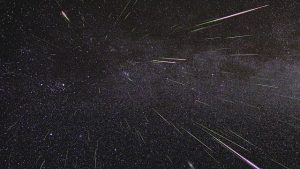
Look up. If your sky is clear tonight and before dawn the next few nights you might see a shooting star. Except it won’t be a star it will be a meteorite. Now is when two meteor showers are putting on a show.
Delta Aquarid is going on now. It is not a major meteorite display but it overlaps the beginning of the Perseid shower.
The Perseids peak mid-August with about 100 meteorites per hour seen about Aug. 11-12 in 2016. Delta peaks this weekend with about 20 meteorites per hour.
Perseids seem to come from the Perseus constellation, thus their name. Actually they are debris from the Swift-Tuttle comet. Look for them in the northeastern sky of the northern hemisphere.
A good site to hear about Perseus is at NASA Science News even though the broadcast is from 2014 and includes that year’s august Super Moon, it is fun to watch and hear. NASA.gov also has more meteorite showers and info.
Tips: The best way to watch for meteorites is to find a spot away from city lights such as the banks of a lake or in a field or park. Early morning before dawn is usually just as good as late night. Be patient and bring a chair or blanket.
